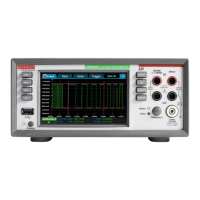Adjustment command timing and error checking
Before each adjustment step, the input of the DMM6500 must be connected to an appropriate
reference signal, as documented in Remote calibration adjustment procedures (on page 3-6).
You must make sure that the correct signal is connected and fully settled before sending the
associated cal.adjust command. Failing to wait for a signal to settle completely may result in a
poor-quality adjustment that could cause the DMM6500 to fail later performance verification.
Once the reference signal is stable, sending the calibration adjustment command initiates internal
measurement operations in the DMM6500. These steps can take from a few seconds to 30 seconds
to complete.
Another method of getting calibration status feedback is to use the TSP prompts mode of operation.
This is especially useful when you are entering cal.adjust commands interactively from an
ethernet Telnet session.
To enable prompts mode, send the localnode.prompts = 1 command. This causes the
DMM6500 to return a TSP> prompt to the computer screen when it has completed a step and is ready
for the next command. Prompts mode also returns a TSP? prompt if an event message is available
(for example, if an error occurs during an adjustment step). See Handling events (on page 3-39) for
more information.
Although not prohibited, prompts mode is not recommended for automated test programs. If prompts
mode is enabled in an automated test, the control program must be constructed to expect and read
each prompt that is sent after each TSP command is processed (including queries). Distinguishing
prompt messages from normal query responses will cause unnecessary complications to the control
program and should be avoided.
Handling events
If an error occurs while performing a calibration adjustment step, the DMM6500 displays an error
message on the front panel. Typically, errors occur during calibration adjustment only if something is
wrong with the test setup or reference signal (for example, if the calibrator output is not enabled
before sending a cal.adjust command). After correcting the cause, the cal.adjust command
that generated an error can be sent again without having to restart the entire calibration adjustment
sequence.An automated test program can check for errors using the eventlog.next() function.
Refer to the DMM6500 Reference Manual for details on eventlog commands. The same text that is
displayed after a cal.adjust error is returned in the eventlog.next() message.

